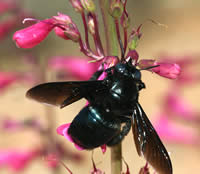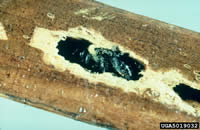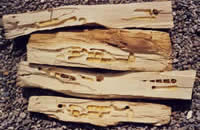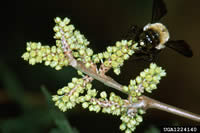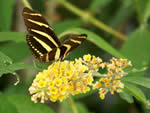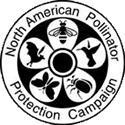USDA Forest Service Celebrating Wildflowers
|
|
|
Carpenter Bees (Xylocopa spp.)By Steve Buchman Along with bumble bee queens, carpenter bees (genus Xylocopa) are the largest native bees in the United States. There are numerous species of carpenter bees that inhabit a broad range of ecosystems from tropical to subtropical to temperate. In the United States carpenters bees can be found across the southern United States from Arizona to Florida and in the eastern United States, north to New York. These gentle giants get their name from their life history habits of excavating precisely rounded galleries inside wood. Using their broad, strong mandibles (jaws), they chew into dead but non-decayed limbs or trunks of standing dead trees. Some species, like the eastern Xylocopa virginica, occasionally take up residence in fence posts or structural timbers, especially redwood, and become a minor nuisance. Inside their rounded branched galleries, they form pollen/nectar loaves upon which they lay their giant eggs (up to 15 mm long). The female forms partitions between each egg cell by mixing sawdust and her saliva together. These partition walls are very similar to particle board!
Carpenter bees are long lived, up to three years and there can be one or two generations per year. Often newly hatched daughters, live together in their nest with their mother. Biologists using observation nests or X-ray imaging techniques have observed returning foragers feeding other nest mates. These observations have led some entomologists to consider carpenter bees primitively social. However, unlike honey bees and bumble bees there are no queen or worker castes, only individual males and females.
In our vegetable and flower gardens, carpenter bees are generalists and may be found foraging on a number of different species. They, like bumblebees are early morning foragers. Carpenter bees land on flower blossoms they become living tuning forks. Using their powerful thoracic muscles carpenter bees sonicate the dry pollen grains out of the flower’s anthers. This type of pollen gathering is called “buzz pollination.” Carpenter bees are excellent pollinators of eggplant, tomato and other vegetables and flowers. From time to time carpenter bees are quite ingenious in their foraging for nectar. On flowers such as salvias, penstemons, and other long, tubular flowers the carpenter bee, due to its large size, is unable to enter the flower opening. Instead they become nectar robbers. Using their mouthparts they cut a slit at the base of corolla and steal away with the nectar without having pollinated the flower. A widespread western US species, Xylocopa varipuncta, has an unusual mating system. Its green-eyed golden males (the females are all black) have huge perfume glands in their thoraces. Territorial males take up positions in non-flowering plants near other males. As a group (lek) they actively release their rose-scented blend of chemicals. Females are attracted from downwind and choose a male with which to mate. |
|
| NOTE: PDF format links require the Adobe Acrobat Reader to view. | |
| top | Disclaimers | FOIA | Privacy Policy | Quality of Information | Photo Credits & Use |
Location: http://www.fs.fed.us/wildflowers/pollinators/pollinator-of-the-month/carpenter_bees.shtml
Last modified: Tuesday, 20-May-2008 15:55:54 EDT
